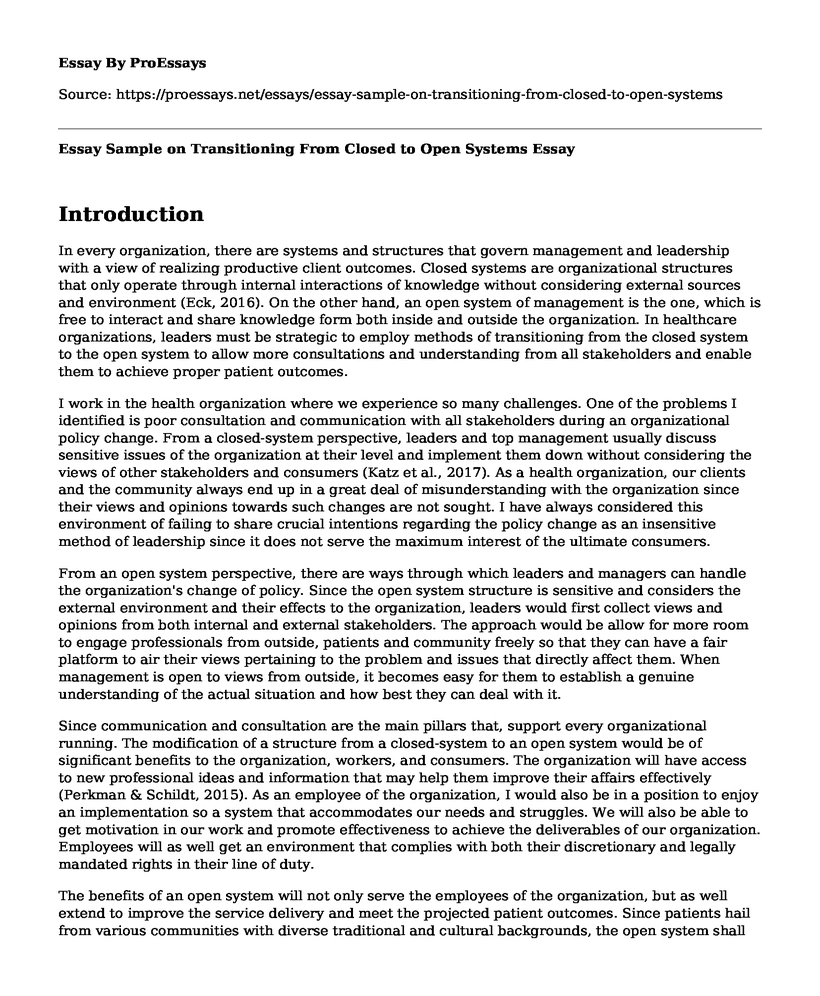Introduction
In every organization, there are systems and structures that govern management and leadership with a view of realizing productive client outcomes. Closed systems are organizational structures that only operate through internal interactions of knowledge without considering external sources and environment (Eck, 2016). On the other hand, an open system of management is the one, which is free to interact and share knowledge form both inside and outside the organization. In healthcare organizations, leaders must be strategic to employ methods of transitioning from the closed system to the open system to allow more consultations and understanding from all stakeholders and enable them to achieve proper patient outcomes.
I work in the health organization where we experience so many challenges. One of the problems I identified is poor consultation and communication with all stakeholders during an organizational policy change. From a closed-system perspective, leaders and top management usually discuss sensitive issues of the organization at their level and implement them down without considering the views of other stakeholders and consumers (Katz et al., 2017). As a health organization, our clients and the community always end up in a great deal of misunderstanding with the organization since their views and opinions towards such changes are not sought. I have always considered this environment of failing to share crucial intentions regarding the policy change as an insensitive method of leadership since it does not serve the maximum interest of the ultimate consumers.
From an open system perspective, there are ways through which leaders and managers can handle the organization's change of policy. Since the open system structure is sensitive and considers the external environment and their effects to the organization, leaders would first collect views and opinions from both internal and external stakeholders. The approach would be allow for more room to engage professionals from outside, patients and community freely so that they can have a fair platform to air their views pertaining to the problem and issues that directly affect them. When management is open to views from outside, it becomes easy for them to establish a genuine understanding of the actual situation and how best they can deal with it.
Since communication and consultation are the main pillars that, support every organizational running. The modification of a structure from a closed-system to an open system would be of significant benefits to the organization, workers, and consumers. The organization will have access to new professional ideas and information that may help them improve their affairs effectively (Perkman & Schildt, 2015). As an employee of the organization, I would also be in a position to enjoy an implementation so a system that accommodates our needs and struggles. We will also be able to get motivation in our work and promote effectiveness to achieve the deliverables of our organization. Employees will as well get an environment that complies with both their discretionary and legally mandated rights in their line of duty.
The benefits of an open system will not only serve the employees of the organization, but as well extend to improve the service delivery and meet the projected patient outcomes. Since patients hail from various communities with diverse traditional and cultural backgrounds, the open system shall bring to the attention of the leadership their history and priorities to enable service delivery capture all their unique needs (Thompson, 2017). In such a scenario, the organization will equally enjoy the benefit of being conversant with the challenges of the target communities and establish a proper risk management strategy that will go a long way to protect their work ethics and standards.
References
Eck, J. (2016). The transitioning role of the healthcare CIO(Doctoral dissertation, The College of St. Scholastica). http://search.proquest.com/openview/ee89206850f7b06989c02b6b3b8ba90c/1?pq-origsite=gscholar&cbl=18750&diss=y
Katz, J. N., Lishmanov, A., Van Diepen, S., Yu, D., Shen, H., Pauley, E., ... & McLaughlin, B. (2017). Length of Stay, Mortality, Cost, and Perceptions of Care Associated With Transition From an Open to Closed Staffing Model in the Cardiac Intensive Care Unit. Critical pathways in cardiology, 16(2), 62-70. https://www.ingentaconnect.com/content/wk/hpc/2017/00000016/00000002/art00004
Perkmann, M., & Schildt, H. (2015). Open data partnerships between firms and universities: The role of boundary organizations. Research Policy, 44(5), 1133-1143. https://www.sciencedirect.com/science/article/pii/S0048733314002248
Santoro, G., Vrontis, D., Thrassou, A., & Dezi, L. (2018). The Internet of Things: Building a knowledge management system for open innovation and knowledge management capacity. Technological Forecasting and Social Change, 136, 347-354. https://www.sciencedirect.com/science/article/pii/S0040162517302846
Thompson, J. D. (2017). Organizations in action: Social science bases of administrative theory. Routledge. https://www.taylorfrancis.com/books/9781315125930
Cite this page
Essay Sample on Transitioning From Closed to Open Systems. (2022, Nov 30). Retrieved from https://proessays.net/essays/essay-sample-on-transitioning-from-closed-to-open-systems
If you are the original author of this essay and no longer wish to have it published on the ProEssays website, please click below to request its removal:
- Food Security Theories
- Adherence in Diabetes Patients Assignments Paper Example
- Early Life Probiotics for Improving Postnatal Outcomes - Research Paper
- The Rhetorical Analysis Paper on Gun Control Ad Titled "No More Silence"
- The Development of a New BSN Program - Paper Example
- Abstract for International and Comparative Disaster Law
- Research Paper Example on Organizational Structure: Key to Achieving Competitive Advantage







